Understanding Skid Steer Nursery Jaws in Agriculture
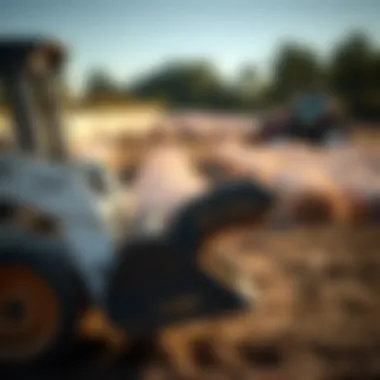
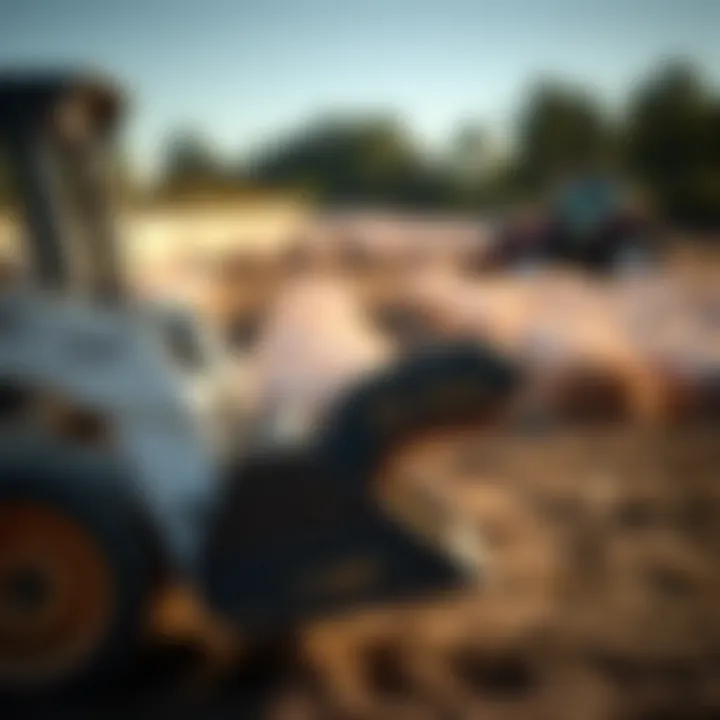
Intro
Skid steer nursery jaws have emerged as essential tools in the realm of horticulture, addressing the nuanced demands of managing plants and trees. These specialized attachments enhance the capabilities of skid steer loaders, enabling operators to perform intricate tasks with precision and efficiency. Whether it’s the handling of delicate saplings or the relocation of bulk materials, nursery jaws are designed to adapt to the diverse needs encountered in a nursery environment.
In this exploration, we aim to shed light on the various functions and applications of these tools, providing a roadmap for both seasoned professionals and those new to the agricultural scene.
Key Concepts and Terminology
Understanding skid steer nursery jaws begins with familiarizing oneself with some fundamental concepts and terminology that distinguish this equipment from others in the agricultural toolkit.
Definition of Terms
- Skid Steer Loader: A versatile piece of machinery used in construction and agriculture, characterized by its wheeled or tracked chassis and arms that can be fitted with various attachments.
- Nursery Jaws: A specific attachment for skid steers, designed with a set of curved, serrated jaws that securely grip and transport plants or materials.
- Horticulture: The art and science of growing fruits, vegetables, nuts, seeds, mushrooms, herbs, sprouts, mushrooms, algae, flowers, seaweeds, and non-food crops such as grass and ornamental trees.
Overview of Relevant Practices
In practical terms, skid steer nursery jaws are often used in a variety of specialized practices:
- Transplanting: Facilitating the movement of young trees and shrubs from one location to another with minimal root disturbance.
- Landscaping: Assisting landscapers in transporting bulky materials or planting larger specimens without damaging them.
- Maintenance: Cleaning up debris in nurseries or gardens, which often requires delicate maneuvering not achievable with standard buckets.
Current Trends and Innovations
The agricultural sector is constantly evolving, and the use of skid steer nursery jaws is no exception. New trends and innovations continue to improve efficiency and effectiveness.
Latest Research and Developments
Recent studies highlight advancements in material science, leading to lighter yet more durable construction of nursery jaws. This development reduces wear and tear on skid steers while enhancing their payload capabilities.
Emerging Technologies and Tools
Integration with technology is another trend gaining traction. For instance, GPS and remote sensing technologies are being incorporated into skid steer operations, allowing for more precise operations, reducing waste, and planning layouts effectively.
Practical Applications
To better grasp the practicality of skid steer nursery jaws, one can consider various hands-on applications in nurseries and landscaping projects.
Step-by-Step Guides
- Attachment Setup: Ensure that the nursery jaws are properly attached to the skid steer using the locking mechanism.
- Calibration: Adjust the loader's hydraulic settings to match the weight and size of the plants or materials being handled.
- Transport: Approach the target plant or material, slowly close the jaws to grip securely, and raise to transport height before moving.
Troubleshooting Common Issues
- Jaw Slippage: If the jaws are slipping, it may be due to improper gripping technique or insufficient pressure set on the hydraulic system.
- Hydraulic Failure: Regular maintenance checks on hydraulic lines can prevent abrupt failures that obstruct work.
Skid steer nursery jaws highlight the fine line between efficiency and delicacy in horticultural practices, proving themselves invaluable in well-run operations.
By understanding these aspects of skid steer nursery jaws, agriculture professionals can make informed decisions. Embracing these tools can indeed lead to improved efficiency and productivity, allowing for smoother operations in the ever-demanding landscape of horticulture.
Prolusion to Skid Steer Nursery Jaws
In the world of modern agriculture, technologies and tools that enhance productivity are paramount. Among these, skid steer nursery jaws stand out as versatile implements widely used in nurseries and landscaping settings. Understanding their function is not just technical jargon; it's about realizing the significant advantages they bring to day-to-day operations.
Definition and Purpose
Skid steer nursery jaws are specialized attachments designed for skid steer loaders. Their primary purpose is to facilitate the handling and transport of trees, shrubs, and other nursery products. With their open design and multi-directional operation, they allow for precise gripping and lifting. These claws extend the utility of the skid steer, turning an already versatile machine into an essential tool for horticultural tasks.
The jaws are engineered to grip securely while minimizing damage to the plants. This is critical, as many nursery operators strive to maintain the health and aesthetics of their stock. By utilizing this attachment, the efficiency of moving plants is greatly enhanced, allowing workers to focus on other important tasks. Ultimately, these attachments can save labor costs, increase safety for the workers, and improve overall workflow in a nursery or landscaping project.
Historical Context
The development of skid steer nursery jaws traces back to the evolution of skid steer loaders themselves, which emerged in the mid-20th century as compact and agile solutions to various agricultural and construction tasks. Early loader designs were primarily intended for basic material handling. However, as the agricultural sector modernized, the need for more specialized equipment became evident.
Initially, nurseries relied on manual labor or rudimentary tools for handling plants. This process was labor-intensive and not always effective, leading to increased costs and sometimes damaged plants. The advent of skid steer loaders addressed some of these challenges, but the lack of targeted attachments limited their application. As horticulture expanded into larger operations, engineers and manufacturers began to innovate, leading to the introduction of specialized nursery jaws.
In the decades that followed, numerous designs evolved, reflecting the demands and feedback from the industry. Today, these attachments have become standard in many nurseries, and their designs continue to improve in relation to durability, efficiency, and functionality. This historical perspective highlights not only technological advancement but also the ongoing dialogue between agricultural practices and machinery development, illustrating a dynamic relationship aimed at optimizing horticultural practices.
Design Features of Nursery Jaws
Understanding the design features of nursery jaws is critical for anyone involved in horticulture. These mechanics provide the backbone for a wide array of agricultural tasks. At their core, nursery jaws serve a distinct purpose: optimizing the collection, transportation, and planting of trees and other large plants. This effectiveness directly stems from their design, which incorporates specific materials, a robust operating mechanism, and a wide array of size and capacity variations.
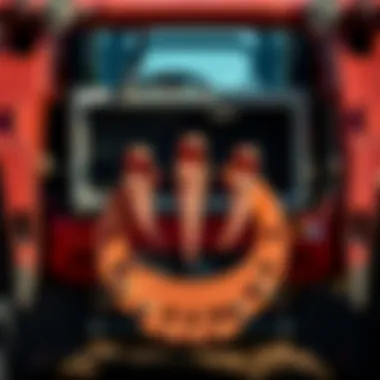

Material Composition
When discussing nursery jaws, we need to begin with what they're made of. The material composition of these tools plays a vital role in their overall performance and longevity. Typically, nursery jaws are crafted from high-tensile steel, which gives them strength and durability. This steel is often coated or painted to resist corrosion, which is essential when working in moist nursery environments.
However, not all maiden jaws are created equal. Some manufacturers may employ a mix of alloys to enhance resistance to wear or to reduce the weight of the equipment without compromising strength. Lightweight materials, like aluminum, have been gaining traction as they offer a good balance between weight and durability, making the tool easier to handle for prolonged periods.
In essence, selecting the appropriate material is a key consideration. Gardeners and farmers must assess the specific conditions their nursery jaws will face - heavy loads, wet conditions, or abrasive soil types will all influence this decision.
Mechanism of Operation
The mechanism by which nursery jaws operate exemplifies their utility in practical applications. Fitted to a skid steer loader, the jaws typically operate using hydraulic systems, translating the loader’s power into movement. This hydraulic mechanism allows for precise control when opening and closing the jaws.
The operation resembles the bite of an animal, where the jaws can tightly grip crops and then engage in a smooth, fluid motion to lift and relocate them with minimal disturbance to root systems. These movements not only safeguard the integrity of the plants but also enable users to maneuver with ease.
It's worth noting that the functionality increases or decreases depending on the loader's specifications, cycle times, and hydraulic flow rates. An optimal setup ensures efficiency and productivity. Every nursery operator must remain mindful of these operational details to maximize the performance of their equipment and prevent any potential mechanical failures.
Size and Capacity Variations
Lastly, size and capacity variations of nursery jaws must be addressed. Just like buying a pair of shoes, finding the right fit for the job is crucial. Nursery jaws come in various sizes to accommodate different plant types and project needs, from small ornamental shrubs to significant trees.
A common size range spans from 36 to 60 inches in width; larger jaws are obviously better suited for bigger tasks, but they can also become cumbersome in tighter spaces. Furthermore, the load capacity also varies – some jaws can open wide enough to handle multiple small plants at once, whilst others are designed for single, larger specimens.
Operators must evaluate their specific horticultural tasks and weigh the pros and cons of each size option. In narrow rows or intricate garden designs, a smaller model might work wonders, whereas larger jaws are indispensable for bulk moves in expansive nurseries.
By understanding these design features, farmers and horticulturists can make informed decisions that enhance their operational efficiency and positively impact their work.
A well-designed nursery jaw, made from the right materials and configured optimally, can drastically improve workflow in nurseries, contributing to better growth outcomes and ultimately higher profits in agricultural practices.
For more information and updates about nursery tools and their design, consider visiting Wikipedia or similar platforms.
Operational Efficiency in Nurseries
Understanding operational efficiency in nurseries is akin to finding the secret sauce in gardening. It encompasses various aspects of nursery management aimed at maximizing productivity while minimizing waste. Getting this right is crucial for anyone involved in horticulture, be it a large-scale operation or a small family business. By using skid steer nursery jaws effectively, nurserymen can achieve impressive results in different areas, but the focus must remain on labor, time, and energy aspects of the operational setup.
Labor Reduction
Labor is often a significant cost in horticultural operations. But with the implementation of skid steer nursery jaws, this cost can be dramatically slashed. These tools simplify tasks that would otherwise require multiple workers or strenuous effort. For instance, when moving large plants or pallets, the jaws securely grasp various items, significantly reducing the need for manual lifting and transport. This not only cuts labor costs but also minimizes the risk of injuries commonly associated with physical labor in nurseries.
The modern nursery is a bustling hub of activity. Having equipment like skid steer jaws at your disposal changes the game. By enabling one operator to handle what would typically require several hands, nurseries can redirect workforce efforts toward more value-adding tasks, like cultivation or monitoring plant health. In essence, using these jaws allows businesses to run leaner by reducing their labor dependency without sacrificing the quality of work.
Time Management
Time is perhaps the scarcest resource for any horticultural enterprise. With demands for efficiency and speed, utilizing skid steer nursery jaws becomes essential. Tasks that would normally take hours can be done in a fraction of the time. The operational design of the jaws allows for seamless transitions between functions—whether it’s for lifting, hauling, or repositioning plants. This leads to an overall boost in productivity.
For busy nurseries, finding ways to save precious time can mean the difference between success and stagnation. When nursery staff members are no longer bogged down by manual lifting or extended transport times, they can focus on critical tasks that promote growth and health in their plants. The ability to enhance time management not only improves output but leads to better margins as well.
Energy Consumption Analysis
Considering energy consumption is another crucial piece of the efficiency puzzle. Skid steer nursery jaws are designed to operate using less energy than other forms of heavier machinery or manual labor. The hydraulic systems in these jaws efficiently control the gripping power and movement, allowing them to complete tasks with minimal energy expenditure.
This is one of those examples where modern technology shines. Studies have indicated that energy-efficient tools contribute significantly to lowering operational costs. Saving on energy means there’s more capital left for investment in other areas, like reinvesting into the nursery for future growth or adopting more sustainable practices. It's a win-win situation.
Efficiency isn’t just about doing things faster; it involves doing things smarter, minimizing strain on resources for optimal output.
Applications in the Horticulture Sector
Skid steer nursery jaws have carved a significant niche within the horticulture domain, where the fine balance between efficiency and productivity is paramount. Their design and functionality provide unique solutions tailored for specific nursery tasks. By addressing the operations related to planting, soil management, and pest control, these tools not only simplify tasks but also enhance the overall productivity of horticultural endeavors.
Tree Transplanting Strategies
When it comes to transplanting trees, the precision and care involved are non-negotiable. Skid steer nursery jaws allow for meticulous handling of trees, ensuring their critical root systems remain intact during the process. Here are some key factors enhancing tree transplanting:
- Robust grip and control: The unique design of the jaws enables the operator to firmly grasp the tree, minimizing the risk of damage.
- Flexible maneuverability: With the ability to navigate tight spaces, skid steers can transport trees to their new locations with precision.
- Reduced labor costs: Handling large trees manually is labor-intensive. Utilizing nursery jaws significantly cuts down on manpower, translating to cost savings.
Not only does this enhance operational efficiency but it also supports better survival rates for transplanted trees, making it a win-win for farmers.
Soil Preparation Techniques
Effective soil preparation is the bedrock of gardening success, and skid steer nursery jaws facilitate this crucial process. Key applications in soil preparation include:
- Soil aeration: The jaws can be engineered to incorporate tools that help aerate the soil, allowing for better root growth and nutrient absorption.
- Soil mixing: Utilizing attachments, the jaws can assist in mixing fertilizer or amendments uniformly throughout the soil, providing essential nutrients that promote healthy plant growth.
- Compaction mitigation: During construction or heavy machinery work, soil often becomes compacted. Skid steers equipped with nursery jaws can assist in breaking up compacted soil, restoring its health and fertility.
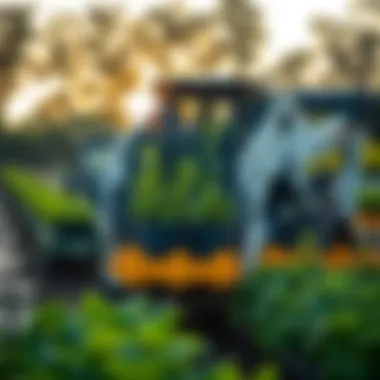
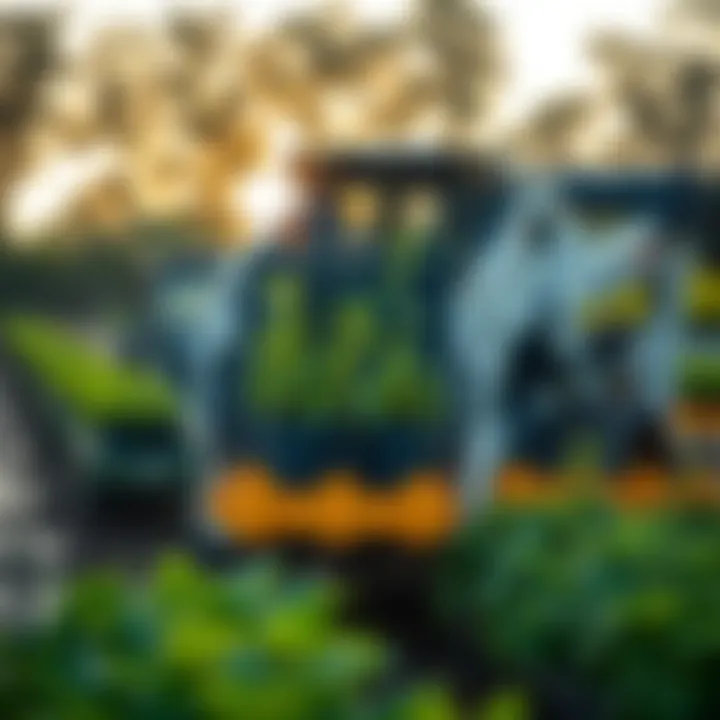
By embedding this technology in soil preparation tasks, horticulturists can enjoy improved growth results, leading to richer yields.
Pest Management Integration
In the modern nursery, pest management is a critical factor that can make or break the success of horticultural practices. Skid steer nursery jaws can play an important role in this area as well:
- Direct application of treatments: With appropriate attachments, nursery jaws allow for the easy application of pest management solutions directly to the affected areas, ensuring precision and reducing wastage.
- Rapid transport of resources: Whether it’s transporting beneficial insects or specific soil treatments, having this tool on hand greatly speeds up the process.
- Adaptability to changes: The ability to easily switch between different attachments for various pest control measures means that operators can adapt quickly to emerging challenges without overhauling their equipment.
Overall, integrating skid steer nursery jaws into pest management practices results in a more streamlined and effective approach to protecting crops.
Ultimately, adopting skid steer nursery jaws translates into smarter agricultural practices that enhance efficiency, sustainability, and crop yields in the horticulture sector.
Comparative Analysis with Alternatives
Understanding the functionality of skid steer nursery jaws isn't complete without putting them alongside other tools used in the horticultural sector. This comparative analysis sheds light on specific elements that help in making informed decisions on equipment utilization. While skid steer jaws offer distinct advantages, their efficiency can only be appreciated when measured against alternatives such as forklifts and dragline equipment. This examination highlights vital considerations, including handling efficiency, operational flexibility, and cost-effectiveness.
Forklifts vs. Skid Steer Jaws
When discussing material handling equipment in nurseries, forklifts and skid steer jaws top the list.
- Handling Efficiency: Forklifts are robust and capable of lifting heavy loads, yet they have limited maneuverability. Their large size can pose challenges in smaller nursery spaces or when navigating tight spots. In contrast, skid steer jaws, attached to compact machines, provide superior flexibility. They can operate in confined spaces with ease, allowing for precision handling that can’t be matched by forklifts.
- Operational Flexibility: Skid steer loaders equipped with nursery jaws can perform a variety of tasks beyond just lifting—like digging and leveling soil. Forklifts are typically confined to lifting and transporting tasks. This versatility means that when using skid steer jaws, a nursery can accomplish multiple operations with a single piece of equipment. The adaptability of skid steer jaws makes them a valuable asset, especially in dynamic nursery environments.
- Cost-Effectiveness: Initial investment and maintenance costs are critical factors for any operation. Forklifts usually require a significant upfront investment and ongoing maintenance. Skid steer jaws, while not cheap, might deliver a better return on investment through their multifunctionality and reduced labor costs. Moreover, given their focused design for specialized tasks in horticulture, they can help in cutting down on those additional machinery expenses.
In summary, while forklifts have their strengths, the precision, versatility, and cost efficiency of skid steer jaws make them a compelling choice for nurseries looking to enhance their operations.
Dragline Equipment Comparison
Dragline equipment is often employed for large-scale earthmoving tasks, but how does it stack up against skid steer nursery jaws?
- Size and Scale: Dragline machines are typically used for extensive projects such as road construction. Their size suits massive operations but can be unwieldy and ill-suited for the specific, smaller-scale tasks found in nurseries. In contrast, skid steer jaws allow for nimble movements and precision handling, which are crucial for the detailed needs of plant management.
- Operational Purpose: A dragline is designed primarily for digging and moving large quantities of earth which shifts its relevance away from everyday nursery tasks like transplanting and shaping soil beds. Skid steer jaws focus mainly on handling trees and vegetation—this targeting stands out as a benefit for nurseries, as it enhances speed and accuracy in those activities.
- Cost Implications: Investing in dragline machinery can be quite a leap financially, particularly when the tasks require more than just soil movement. Skid steer jaws present a more approachable financial option because of their utility in diverse functions within the nursery.
In essence, analyzing alternatives like forklifts and draglines in relation to skid steer nursery jaws not only illustrates their strengths but also equips horticulturalists with insights needed for optimal equipment choice.
For further reading on machinery comparisons in agriculture, you may visit Britannica on Agricultural Machinery or Wikipedia's Guide to Material Handling.
Meanwhile, for discussions and insights from the farming community, forums like Reddit can be quite enlightening.
Maintenance and Durability Considerations
Ensuring the operational longevity of skid steer nursery jaws is a crucial aspect that should not be overlooked. These tools, designed for heavy-duty applications in the agricultural sector, require regular maintenance to perform at their best. Proper maintenance not only extends their lifespan but also ensures that they operate efficiently, reducing unforeseen breakdowns that could stall nursery operations. By emphasizing routine checks and repairs, users can safeguard their investment and enhance productivity in daily tasks.
Routine Inspection Guidelines
Routine inspections play a vital role in keeping skid steer nursery jaws in frontline condition. A successful maintenance regime typically includes the following assessment techniques:
- Visual Inspection: Regularly review the jaws for any visible signs of wear and tear, such as cracks, bent components, or loose fittings. This is a quick way to spot potential problems before they escalate.
- Hydraulic Checks: Inspect the hydraulic systems for leaks or signs of pressure loss. Hydraulic fluid levels should be checked frequently to ensure optimal performance.
- Connection Tightness: Ensure that all bolts and connections are secured tightly. A loose bolt might not only make the machine less effective but can also lead to more severe damage if not attended to.
- Greasing: Regularly lubricate all moving parts as recommended by the manufacturer. This reduces friction and helps to prevent premature wear.
Performing these checks monthly, or even weekly during peak operational times, helps in identifying issues early on.
Common Issues and Repair Strategies
Even with scrupulous maintenance, skid steer nursery jaws might face some common issues. Understanding these problems and having strategies in place could make all the difference:
- Worn Teeth: The teeth on the jaws may wear out over time, which diminishes their effectiveness in gripping and moving materials. If signs of wear are observed, consider replacing them promptly to maintain operational efficiency.
- Hydraulic Cylinder Failure: A malfunctioning hydraulic cylinder can halt operations. To rectify this, regularly check the cylinders for any signs of hydraulic fluid leaks and replace seals as needed. If damage is severe, a cylinder replacement might be necessary.
- Damage to Attachment Frames: The attachment frames can warp from heavy use, impacting their functionality. Reinforcing these frames or employing a more robust material for replacements can solve the issue.
- Frequent Component Breakages: If specific components break often, it’s a signal to reevaluate the components being used or the operating methods employed. Switching brands or using OEM parts can often rectify performance challenges.
Addressing issues promptly is key to avoiding costly downtime and keeping operations running smoothly.
Future Trends in Skid Steer Technology
The landscape of skid steer technology is evolving rapidly, much like the crops that farmers tend to daily. Understanding these shifts is essential for those within the agricultural sphere, as it holds implications not just for machine performance but also for operational efficiency and sustainability. Enhancing the capabilities of skid steers, particularly nursery jaws, is vital for a modern agricultural practice that aims to maximize productivity while mitigating ecological impact.
Automation and Robotics
Automation is no longer a far-off dream; it’s here, and it’s working its way into skid steer technology. Advanced robotics are taking root, undoubtedly changing how tasks are carried out in nurseries. With the integration of automation, numerous benefits hover on the horizon.
This technology aims to reduce the human element in potentially hazardous tasks, such as heavy lifting and movement of materials. Many would argue that the real hero here is precision—automated systems offer consistency in operations, reducing the likelihood of mismanagement.
Key benefits of automation:
- Increased Precision: Reduces errors in handling delicate plants, minimizing damage to nursery stock.
- Save Time: Automation allows operations to run around the clock without the need for breaks, resulting in more work getting done in less time.
- Labor Flexibility: With automated systems in place, workers can focus their efforts on high-skill tasks rather than physical labor.
While the idea of robots taking over may spark concerns, the industry is gearing towards a partnership model. This means that human workers and robotic systems can efficiently synergize, leveraging strengths that both possess, ensuring smooth operations in the field.
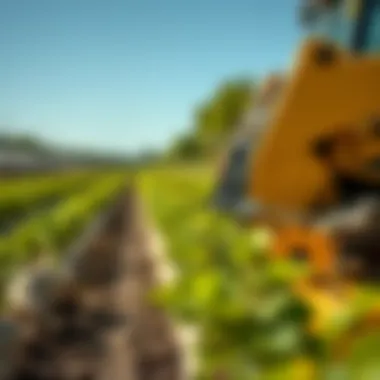
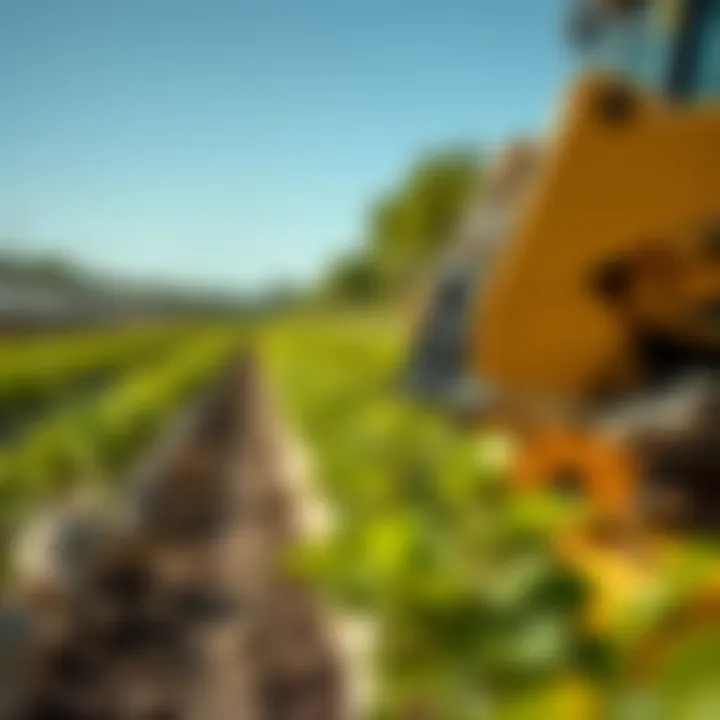
Sustainable Practices Integration
As the agriculture sector faces rising scrutiny concerning environmental impacts, integrating sustainable practices within skid steer technology is becoming increasingly paramount. Equipment such as skid steer nursery jaws is at the forefront of this movement.
One of the primary areas of focus is energy efficiency. Innovations are trending towards machines that consume less fuel and operate using alternative energy sources. This not only cuts down operational costs but also curtails the carbon footprint left behind. The future is likely to see more skid steer models powered by electric or hybrid systems, indicating a significant leap toward sustainability.
Considerations for sustainable integration:
- Material Use: Advances in materials, such as lighter and more durable composites, enhance machine efficiency while lessening the environmental toll.
- Ecosystem-Friendly Operations: Designs that minimize soil disturbance during operation are crucial for preserving nursery health and ecosystem balance.
- Waste Reduction: Skid steer jaws equipped with the ability to interact smartly with surroundings can better manage materials, reducing waste and improving resource utilization.
The integration of such practices signals an overarching commitment to sustainability in agriculture, ensuring that skid steers aren’t just machines, but tools for fostering a greener future.
"Embracing technology isn't just about efficiency; it's about evolving our responsibility towards the environment."
As the agricultural landscape transforms, staying attuned to these nascent trends in skid steer technology will empower farmers to adapt and thrive in an increasingly competitive and eco-conscious marketplace.
Economic Impact on Agricultural Practices
The economic impact of skid steer nursery jaws extends far beyond their initial acquisition cost. They signify a transformative shift in how agricultural labor is performed, influencing efficiency and productivity across the horticulture sector. As farmers and horticulturists consider their investments, understanding the tangible and intangible benefits of these versatile tools becomes crucial. The importance of evaluating this impact lies in recognizing the broader implications for cost management, labor allocation, and sustainable agricultural practices.
Cost-Benefit Analysis
Analyzing the cost-benefit ratio of skid steer nursery jaws is essential for anyone in agriculture. On the surface, the costs associated with purchasing and maintaining these machines may seem steep, but a closer look reveals how quickly they can pay for themselves.
- Initial Investment vs. Long-term Savings: While the upfront cost is significant, the ability to complete tasks faster reduces labor expenses. For instance, transplanting trees or moving bulk soil becomes much less time-consuming, allowing farm workers to focus on other essential tasks, thereby maximizing operational time.
- Efficiency Boost: Skid steer jaws drastically improve operational efficiency. They can handle bulky materials, significantly reducing the number of trips back and forth needed to complete a task. This efficiency helps farmers save on fuel costs, which can be a major part of operational expenses.
- Durability and Maintenance: Investing in high-quality skid steer jaws that require minimal maintenance will lead to less downtime and fewer unexpected repairs. This reliability further enhances overall productivity, ensuring that resources are allocated effectively.
In summary, when farmers weigh the pros and cons, they often find the long-term financial benefits outweigh the initial investment. A good rule of thumb includes calculating the return on investment (ROI) over time to illustrate this concept clearer.
Market Demand and Supply Factors
The market demand for skid steer nursery jaws is tightly interwoven with larger agricultural trends. As the global population continues to grow, so does the need for efficient and effective agricultural practices. Understanding market dynamics can help farmers make more informed decisions regarding equipment purchases and practices.
- Increasing Demand for Sustainable Practices: There's a noticeable shift towards sustainable agriculture. Tools like skid steer jaws are increasingly sought after due to their ability to minimize soil disturbance and facilitate better planting techniques. Many nurseries are leaning towards sustainability, which increases demand for such equipment.
- Supply Chain Influences: The availability of skid steer nursery jaws is also influenced by manufacturing capabilities. Disruptions in supply chains can lead to price fluctuations. Farmers need to keep a close eye on supply trends to plan their purchases and investments accordingly.
- Consumer Preferences: As consumers become more environmentally conscious, they prefer products that are cultivated using sustainable practices. This user preference drives the market dynamics for agricultural equipment, including skid steer jaws, which enhance crop management and handling efficiency.
Evaluating these market factors ensures farmers stay ahead of the game. Staying in tune with supply and demand can significantly improve both operational efficiency and profitability.
Investing in the right tools at the right time not only impacts immediate productivity but can also shape the future landscape of agricultural practices.
Expert Opinions and Insights
Interviews with Industry Professionals
To get a real grip on the functionality and applications of skid steer nursery jaws, there's nothing quite like taking a leaf out of the book from those who live and breathe it every day. Recently, several industry professionals shared their insights on how these tools have transformed their approach to nursery management. It is clear that practical experience sheds light on the nuances of these machines, often missed in theoretical discussions.
In one interview with a long-time nursery operator, the focus was placed on durability and adaptability. They highlighted how changing conditions in nursery spaces often require flexibility in approaches, which skid steer jaws provide. "These jaws aren't just attachments; they are a lifeline for efficiency," she stated plainly. Her perspective underscores a key element: the necessity for machinery that meets the changing tides of agricultural needs. Whether it is for lifting robust tree specimens or providing precise soil preparation, the adaptability of the jaws caters to diverse horticultural demands.
Another interview brought another layer to the table, discussing the economic implications of using skid steer jaws. A consultant specializing in nursery efficiency remarked on how these tools reduce labor costs significantly. He provided a comparative analysis of labor hours saved when using jaws versus traditional hand tools. His calculations showed a cut in labor costs by upwards of thirty percent. This assertion resonates with many entrepreneurs looking to maximize profit margins under tight budget constraints.
Workshop Summaries and Findings
Workshops focused on skid steer technology further illuminate the potential and best practices for using nursery jaws effectively. At a recent horticulture expo, workshops offered hands-on demonstrations, allowing participants to experience not just the operation but the operational advantages firsthand.
Findings from these workshops repeatedly emphasized the importance of training. Some attendees expressed a common frustration with newcomers struggling to acclimate to the machinery. In response, experts recommended structured training modules that focus on safe and efficient handling of the jaws. Clear communication about their function, maintenance, and precise use encourages proper usage, reducing the likelihood of costly errors in operation.
One noteworthy takeaway was the integration of innovative features in skid steer jaws that optimize their utility. Attendees learned about the latest attachment enhancements that provide greater control over gripping and lifting, which is essential when working with delicate plant materials. The industry is moving towards a future where machinery not only connects with human operators but also other tech, like data-driven agricultural practices, to ensure truly beneficial application.
"Training is as vital as the jaws themselves. An empowered operator is an efficient operator."
Overall, both interviews and workshops echoed the sentiment that expert opinions play a crucial role in demystifying skid steer nursery jaws. Through real-world applications and shared knowledge, these discussions help nursery operators make informed decisions that cut costs and boost productivity. As these insights trickle back to the wider agricultural community, it becomes ever more clear that practical expertise is a cornerstone of efficient agricultural operations.
The End and Summary
In wrapping up our exploration of skid steer nursery jaws, it becomes clear that these tools serve as valuable assets within the agricultural landscape. Their design intricately balances functionality and efficiency, allowing for streamlined operations in nurseries and other horticultural settings. The emphasis on reducing labor requirements, managing time wisely, and lowering energy consumption cannot be overstated. These categories are not just buzzwords but practical advantages that ultimately improve productivity.
Moreover, the variety of applications discussed—from tree transplanting to pest management—illustrate the versatile nature of skid steer nursery jaws. They adapt to numerous operational needs, highlighting their essential role in modern farming practices. As technology continues to evolve, the significance of these tools is likely to expand.
"The integration of skid steer nursery jaws is a smart strategy for any horticultural operation focused on maximizing efficiency and minimizing costs."
Key Takeaways
- Versatile Applications: Skid steer nursery jaws can handle a broad range of tasks, from moving trees to preparing soil, making them indispensable in nursery operations.
- Enhanced Efficiency: These tools significantly cut down on labor force needs while offering time savings that can directly improve productivity.
- Future-Proof Technology: With ongoing advancements in automation and robotics, skid steer nursery jaws are poised to remain a central component of agricultural technology. Their adaptability will only increase, likely leading to even more efficient designs and uses.
Future Outlook for Skid Steer Nursery Jaws
Looking ahead, the future for skid steer nursery jaws seems bright. As agriculture becomes increasingly technology-driven, these tools are expected to incorporate smarter features, potentially aligning with automated systems to further enhance performance. The trend toward sustainability in farming practices also presents a fertile ground for innovations in nursery jaws, designed to operate with greater eco-friendliness.
As farmers and enthusiasts alike seek methods to optimize their operations, the role of skid steer nursery jaws will likely evolve, paving new pathways for efficiency in horticulture. The continued prioritization of cost-effective methods in agriculture spells a promising future for these tools, ensuring they remain integral in the ever-changing agricultural landscape.







